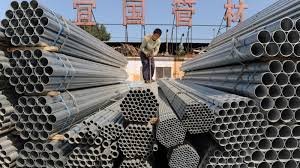Globaltraded.com — The return of Donald Trump to the presidency of the United States has sent ripples across the global trade landscape. For exporters in the European Union, his reelection brings renewed uncertainty, as it signals a potential revival of the protectionist policies and “America First” rhetoric that defined his first term. While the European bloc has long been one of the most significant trading partners of the United States, the road ahead may demand adaptation, resilience, and strategy from European businesses looking to maintain their foothold in the American market.
The European-American Trade Relationship: A Vital Link
The U.S. is one of the EU’s largest export markets, with goods ranging from automobiles and machinery to pharmaceuticals and luxury items flowing across the Atlantic. In 2022 alone, EU exports to the U.S. amounted to nearly $500 billion, cementing the transatlantic trade partnership as one of the most significant in the world.
However, the landscape of this partnership is heavily influenced by U.S. policy decisions. Trump’s first term saw tariff wars, particularly with China, but also with Europe. The EU found itself targeted by tariffs on products such as steel, aluminum, and aircraft components, as well as retaliatory measures against European agricultural products in response to disputes over subsidies.
With Trump’s return, European exporters face the possibility of:
- Renewed Tariffs: A potential resurrection of tariffs on key European exports, especially in industries such as steel, aluminum, and automotive manufacturing.
- Trade Agreement Renegotiations: Trump’s disdain for multilateral agreements raises questions about the future of existing trade arrangements.
- Buy American Initiatives: A strengthening of government procurement policies favoring domestic suppliers could limit opportunities for European firms.
Challenges Ahead for European Exporters
- Increased Costs Due to Tariffs
Trump’s tariff-heavy approach during his first term revealed a preference for addressing trade imbalances by penalizing foreign imports. Should similar policies resurface, European exporters may find themselves bearing increased costs. This is particularly concerning for high-value goods such as automobiles, machinery, and wine, where even small percentage increases in tariffs can erode profitability.
- Regulatory Hurdles
The Trump administration had a reputation for tightening regulations on foreign imports under the guise of national security and consumer safety. European pharmaceutical and technology companies could face stricter scrutiny, slowing market entry and increasing compliance costs.
- The Dollar’s Strength
Trump’s return could bring heightened volatility to global currency markets. A stronger dollar, spurred by policies promoting U.S. economic growth, could make European goods more expensive for American buyers, reducing competitiveness.
- Fragmentation of Multilateral Trade Alliances
Trump’s preference for bilateral negotiations over multilateral agreements could weaken the EU’s collective bargaining power. Without the leverage of the bloc, individual member states may struggle to negotiate favorable terms with the U.S.
Strategies for European Exporters
In the face of these challenges, European exporters must adopt proactive strategies to ensure their survival and growth in the U.S. market.
- Diversify Export Markets
While the U.S. remains a lucrative market, reliance on it as a primary destination poses risks. European exporters should explore opportunities in emerging markets across Asia, Africa, and South America. Diversification mitigates the impact of any single country’s protectionist measures.
- Leverage Local Partnerships
Establishing partnerships with U.S.-based companies, including distributors, wholesalers, and manufacturers, can help European exporters navigate the complexities of the American regulatory environment. Local partnerships also bolster lobbying efforts against unfavorable trade policies.
- Adapt to Local Preferences
Customizing products to align with American consumer tastes can boost competitiveness. Whether it’s tailoring food products to match local flavors or modifying automobile designs to suit American preferences, adaptation is key.
- Optimize Supply Chains
Efficient supply chain management is crucial to mitigating the impact of tariffs. European exporters should:
- Explore production facilities in tariff-free regions.
- Utilize Foreign Trade Zones (FTZs) in the U.S. to reduce import costs.
- Streamline logistics to cut down on transportation expenses.
- Invest in Branding and Marketing
American consumers are drawn to stories behind products. European exporters should emphasize the heritage, quality, and sustainability of their offerings. Branding campaigns highlighting these aspects can differentiate products in a competitive marketplace.
- Focus on High-Value Segments
Rather than competing on price, European exporters should focus on high-value market segments where they hold a competitive advantage. Luxury goods, high-tech machinery, and innovative pharmaceuticals are examples of sectors where European companies can maintain strong market positions.
- Stay Ahead on Compliance
Keeping abreast of U.S. regulatory requirements is essential. Exporters must work with legal experts to ensure their products meet stringent American standards. Additionally, adopting environmentally friendly practices can preempt any green regulations that may arise under state-level legislation.
- Hedge Against Currency Risks
Currency hedging can protect against dollar fluctuations, ensuring price stability for American buyers. Forward contracts and options are tools exporters can use to safeguard their profits.
Long-Term Implications
Trump’s reelection could set the stage for a prolonged period of uncertainty in transatlantic trade relations. European exporters must balance their immediate need to adapt with a long-term vision of resilience. Strengthening relationships with U.S. policymakers and industry stakeholders will be essential for shaping a favorable business environment.
Moreover, the EU itself must advocate for the preservation of free trade principles on the global stage. A unified approach to engaging with the U.S. could prevent member states from becoming isolated in bilateral negotiations.
The re-election of Donald Trump presents European exporters with both challenges and opportunities. While protectionist policies may complicate access to the U.S. market, they also spur innovation and adaptation. By embracing strategic planning, leveraging local partnerships, and investing in branding, European exporters can not only survive but thrive in the face of a second Trump administration.
In this ever-evolving landscape, flexibility and foresight will determine which companies succeed. As the transatlantic trade relationship enters a new chapter, European exporters must write their own story of resilience and reinvention.
























































